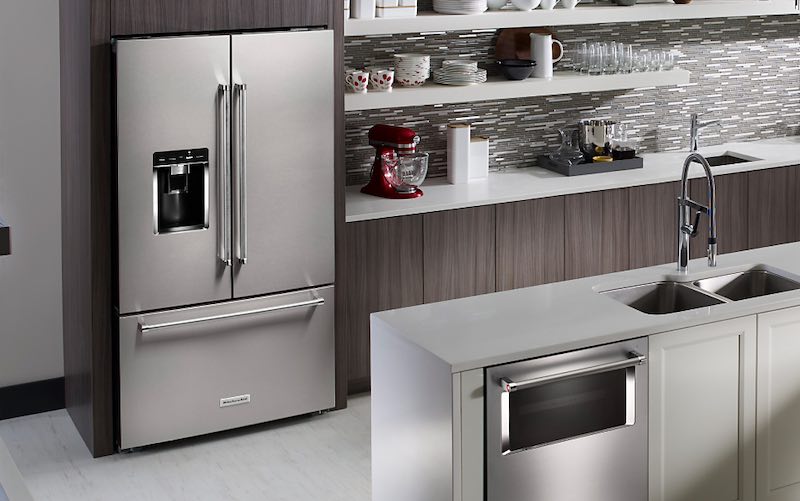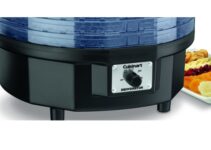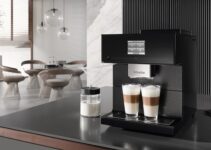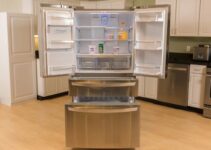The Kitchenaid Refrigerator comes packed with a lot of features to suit every refrigerating need. However, you would need to properly understand how these settings work before you can make use of them and maintain food freshness while ensuring your appliance lasts longer.
In this guide, we will delve into the different temperature settings, explain why they matter, and provide step-by-step instructions on how to tweak them for optimal performance.
Kitchenaid Refrigerator Temperature Settings Explained

Kitchenaid Refrigerator Temperature Settings
- Refrigerator Compartment: The refrigerator compartment is where you store perishable items like fruits, vegetables, dairy, and drinks. To keep your food fresh, set the refrigerator temperature between 35°F and 38°F (1.7°C and 3.3°C). This temperature range slows down the growth of bacteria and helps your fruits and vegetables stay crisp.
- Freezer Compartment: The freezer compartment keeps your frozen foods in great condition. To ensure your food stays frozen without freezer burn, set the freezer temperature between 0°F and 5°F (-18°C and -15°C). This temperature range keeps your frozen foods flavorful, preserves their texture, and maintains their nutritional value.
Why Temperature Settings Matter
Temperature control is important if you want to ensure both food safety and quality. Here’s why the right temperature settings are important for your KitchenAid refrigerator:
- Food Preservation: When you set the proper temperature, you create an environment that slows down the growth of bacteria, reducing the risk of food spoilage. This means your food stays fresh for longer, saving you money and reducing waste.
- Energy Efficiency: When your refrigerator operates within the recommended temperature ranges, it consumes less energy, which means lower electricity bills. So, by using the right temperature settings, you get to save money.
- Food Quality: The right temperature settings help maintain the taste, texture, and nutritional value of your food. By keeping your ingredients fresh, you can enjoy better-tasting meals and healthier options.
Adjusting Temperature Settings
If this is you first time owning a KitchenAid refrigerator, you can follow the guide below on how to adjust the temperature settings for optimal performance:
- Finding the Controls: Look inside your refrigerator for buttons, dials, or touch panels that control the temperature. These are usually located on the rear wall or ceiling of the fridge. You can also check the user manual on how to locate the controls.
Default Temperature Settings: When you first set up your KitchenAid refrigerator, the default temperatures may align with the recommended ranges. Start by setting the refrigerator temperature to 37°F (2.8°C) and the freezer temperature to 0°F (-18°C). Allow the appliance to stabilize for 24 hours before making further adjustments.
Best Kitchenaid Refrigerator Temperature Settings
If you’re planning on storing a variety of foods in your kitchen, this guide would help you with the different Kitchenaid refrigerator temperature settings to try out.
Fruits and Vegetables
Fruits and vegetables require cool temperatures to stay fresh. Keep the temperature between 35°F and 38°F (1.7°C and 3.3°C). This range helps slow down the ripening process and preserves the nutritional value of your produce. Store fruits and vegetables in sealed containers to prevent moisture loss.
Dairy Products
Dairy products like milk, yogurt, and cheese should be stored at a slightly colder temperature to maintain their freshness and prevent spoilage.
You need to set the temperature to around 35°F (1.7°C) to keep dairy items in the best condition. When it comes to storage, you would want to place dairy products on the middle or upper shelves of the refrigerator, as these areas have more consistent temperatures.
Meat and Poultry
Raw meat and poultry are highly perishable and require colder temperatures to prevent bacterial growth. Set your refrigerator temperature to around 35°F (1.7°C) to keep meat and poultry safe.
With raw meat and poultry, there is the issue of cross-contamination. To ensure this doesn’t happen, you should store raw meat and poultry on the lowest shelf or in the meat drawer, away from other food items.
Seafood
Seafood, including fish and shellfish, is highly sensitive to temperature changes. Set your refrigerator temperature to around 32°F (0°C) to maintain the quality of seafood.
Seafood is best stored in airtight containers or wrapped tightly in plastic wrap. This will prevent odors from spreading to other foods in the refrigerator.
Beverages
For beverages like water, juice, soda, and wine, a slightly cooler temperature is ideal. The best temperature setting would be around 37°F (2.8°C) to keep the beverages refreshing. Beverages are easy to store, so you can place them on the middle shelves or in the door compartments for easy access.
Freezer Foods
Frozen foods, including pre-packaged meals, ice cream, and frozen fruits and vegetables, require a freezer temperature of 0°F (-18°C) or slightly below to stay frozen and maintain their quality. Your freezer should be set to this temperature range with frozen items stored in designated freezer compartments or freezer bags to prevent freezer burn.


![Keurig Not Working After Cleaning with Vinegar [FIXED] Keurig Not Working After Cleaning with Vinegar [FIXED]](https://homestuffmag.com/wp-content/uploads/2023/04/keurig-not-working-after-cleaning-with-vinegar-211x150.jpg)

![Whirlpool WRX735SDBM02 Ice Maker Not Working [FIXED] Whirlpool WRX735SDBM02 Ice Maker Not Working [FIXED]](https://homestuffmag.com/wp-content/uploads/2023/04/Whirlpool-WRX735SDBM02-Ice-Maker-Not-Working-211x150.jpg)
